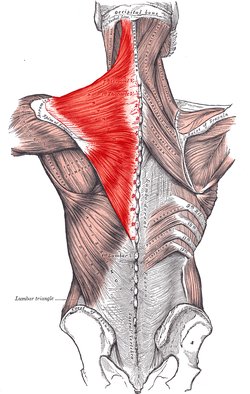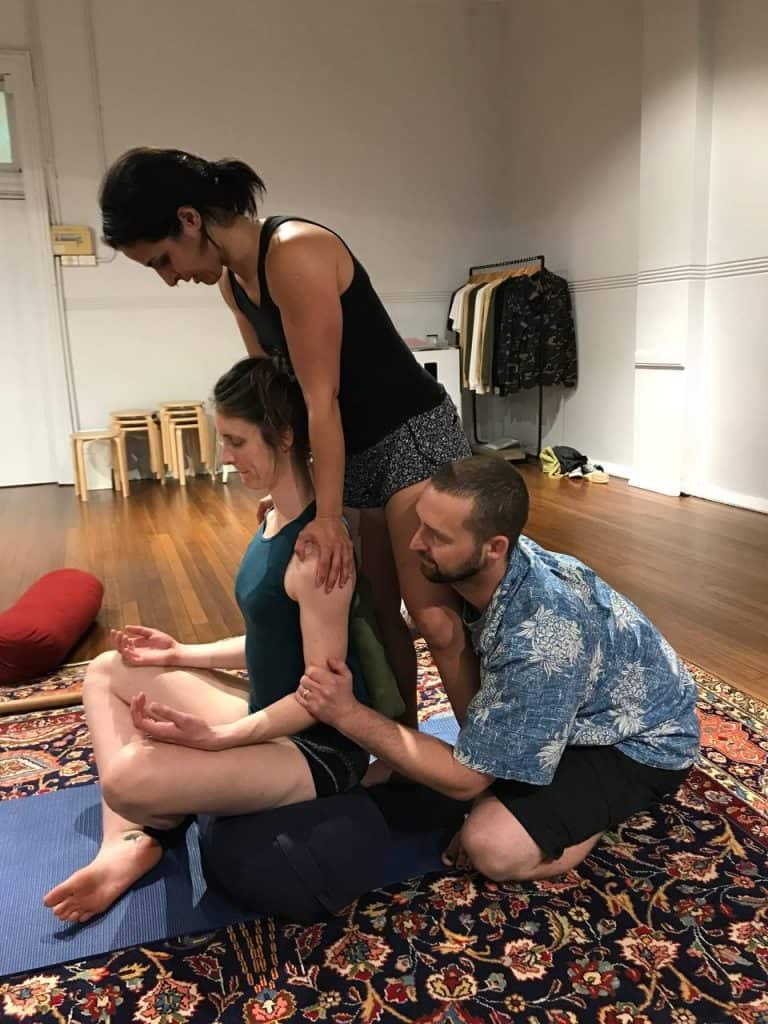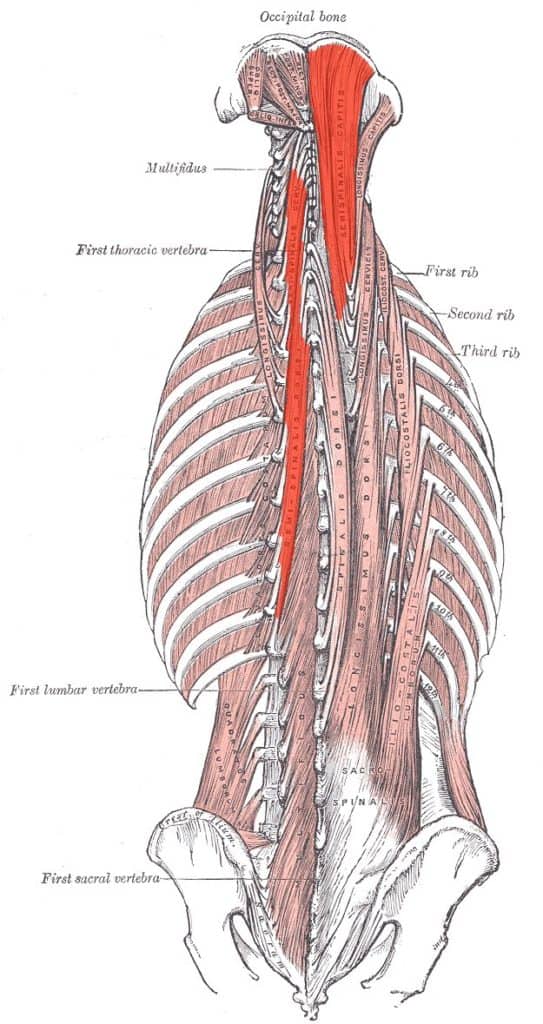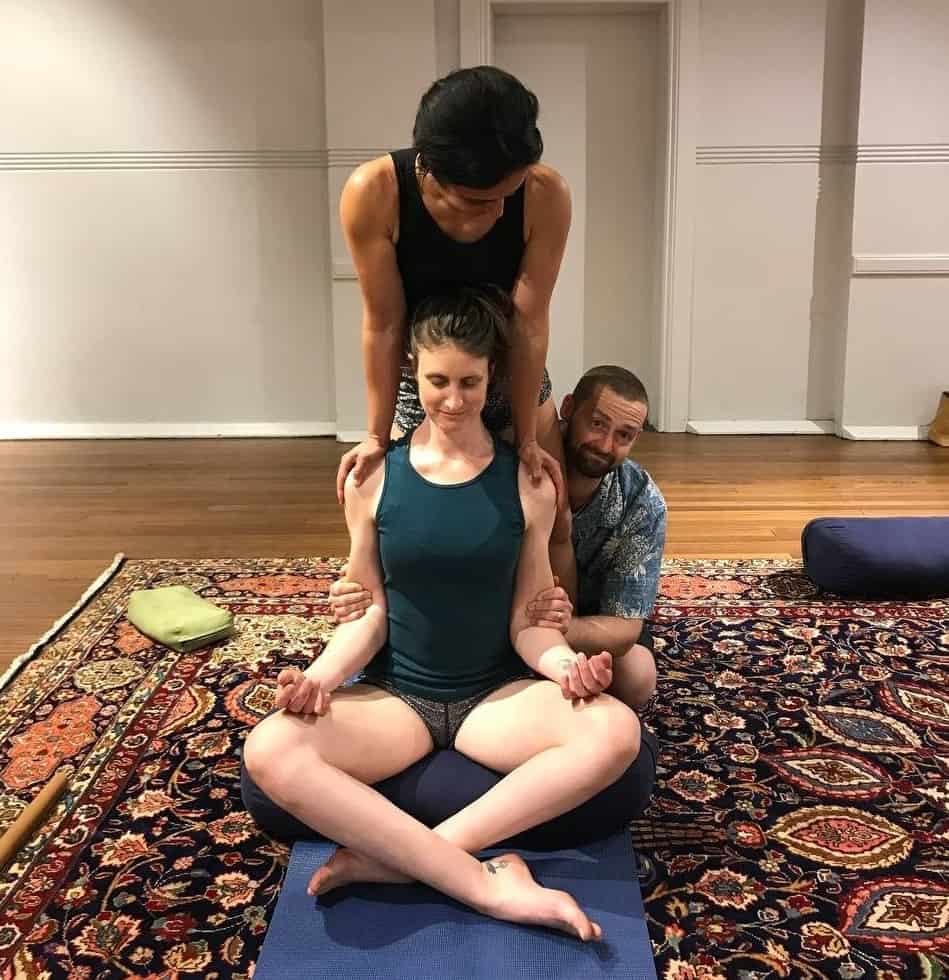[*] the shoulder anchor [a.k.a ‘shoulder push-down’, artist formerly known as ‘shoulder depression’] [base ingredient]
Let us turn our attention, on this here Day of the Moon, to a real ‘crowd pleaser’ of a stretch.. at least in its basic form.
The ‘shoulder push-down’; performed with one partner assisting from behind with two hands [not shown here]; baring down mass through straight arms and relaxed hands – is a extremely popular stretching posture from the art of Stretch Therapy.
At lot of the effect in the basic form is targeted and produced via the relaxation and repatterning of the trapezius muscle [specifically the upper fibres, thereof]. This one is like garlic, salt or oil. You can have it every day and never get sick of it.

The trapezius muscle is curious in that it [along with the sternocleidomastoid ‘SCM’] draws enervation from the eleventh cranial nerve; not from the spinal nerves as most muscles do. Perhaps this – or perhaps other factors to do with character armour, somatic storing of anger and stresses of life, or something else entirely – has to do with its profound ability to relax the system.
Whatever the reasoning, this stretch is a very simple posture for eliciting relaxation in people. It is also one of the premier postures for teaching a cycle of contract-relax to a beginner.
It can be done at the end of a session [even a strength session] as a ‘finisher’; throughout the day as a standalone exercise for the desk-bound; as a ‘state induction’ exercise to begin a stretching session [sort of wiping the slate clean of the days ambient stress and dropping the person ‘into tha body’]. All fine uses!
It has some more powerful expressions, too, hence why I have group them under the name ‘the shoulder anchor’. The basic set-up remains the same [anchor shoulder girdle], whilst what happens after is determined by the cuisine and the spices and herbs added.

Once the body has acclimatized to the posture and cleared the basic tension of the day, one can take a number of lines of work from this posture.
The ‘anchorage’ can be applied to one or both shoulders. This can feel strong but safe for some people, particular those who have had serious neck injuries in the past [possible not fully rehabbed ones, especially]. The support of the partners leg [the soft part, not the shin bone] on the back provides a extra dimensionality to the ‘locked in’ feel, that is very comforting and relaxation facilitating.
If one elects to utilize the one-handed anchorage, there are a number of exceptional additions featured in [K]’s stretching books and the ST video products. The one that targets levator scap is exceptionally potent.. just not ‘pleasant’ for most for a very long time, indeed!
I crafted a series of strong seated versions that are enhanced via the ‘spice of mass’. One of the common complaints in this posture is that after one gets used to it, one always wants ‘more massss!!‘.
Sitting on the shoulder with a cushion got partially around this, but again the traps are very strong in leverage. This being said there is a ratio of mass-to-ability-to-yield-and-melt-to-mass that for some these seated versions passed a crucial threshold.
The version shown in the photographs above is the ‘Straight-jacket’ shoulder anchor exercise. This one, via ‘catching’ and ‘drawing the sinews’ of the arms down, greatly enhances a number of aspects of the posture. There are two-, three- and even four-partner versions of this. This elicits some of the ‘sea of proprioception’ effects that the Body Tessellation order stretches are designed to emphasize.
If we pause and look at the anatomy for a moment, we can see that this setup allows – in time, and with practice – access to a huge array of muscles and soft tissues.
I have found work on the splenius group from this posture to be exceptional. Later one can get into the semispinalis and all those other sinewy 4th layer spine muscles. And for alchemical purposes, we do want to do this – in time and in a digestible fashion, of course.
But first one starts on the outside layer of the onion.
The one-handed/one-sided-seated versions offer a powerful bonus effect related to the insertion of the muscles being pinned, whilst he origin is made to move. This was a hidden principle of stretching that [K] introduced me to. A lot of the best postures, IMHO, possess this quality. These are the ones that are usually best for repatterning purposes, whereas the others still hold flexibility and motion unlocking benefits.
There we have it – another versatile ‘base ingredient’, that can be used in a number of differing cuisines.
[D]
[anatomical imagery is from Gray’s Anatomy]


